HONDA PRELUDE 1998 Owners Manual
Manufacturer: HONDA, Model Year: 1998, Model line: PRELUDE, Model: HONDA PRELUDE 1998Pages: 278, PDF Size: 2.61 MB
Page 211 of 278
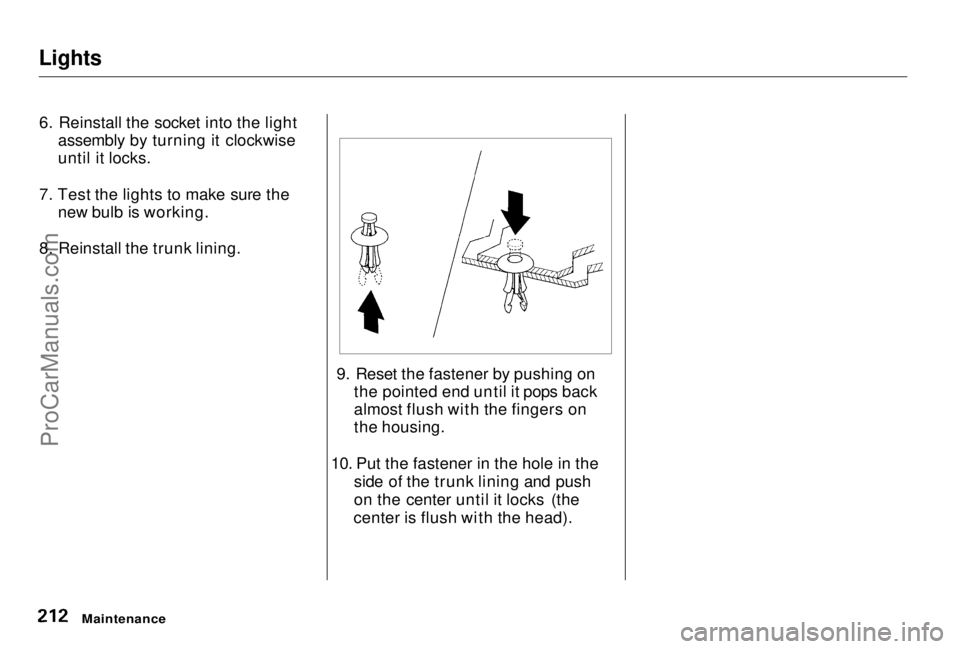
Lights
6. Reinstall the socket into the light assembly by turning it clockwise
until it locks.
7. Test the lights to make sure the new bulb is working.
8. Reinstall the trunk lining.
9. Reset the fastener by pushing onthe pointed end until it pops back
almost flush with the fingers on
the housing.
10. Put the fastener in the hole in the side of the trunk lining and push
on the center until it locks (the
center is flush with the head).
MaintenanceProCarManuals.comMain Menu Table of Contents s t
Page 212 of 278
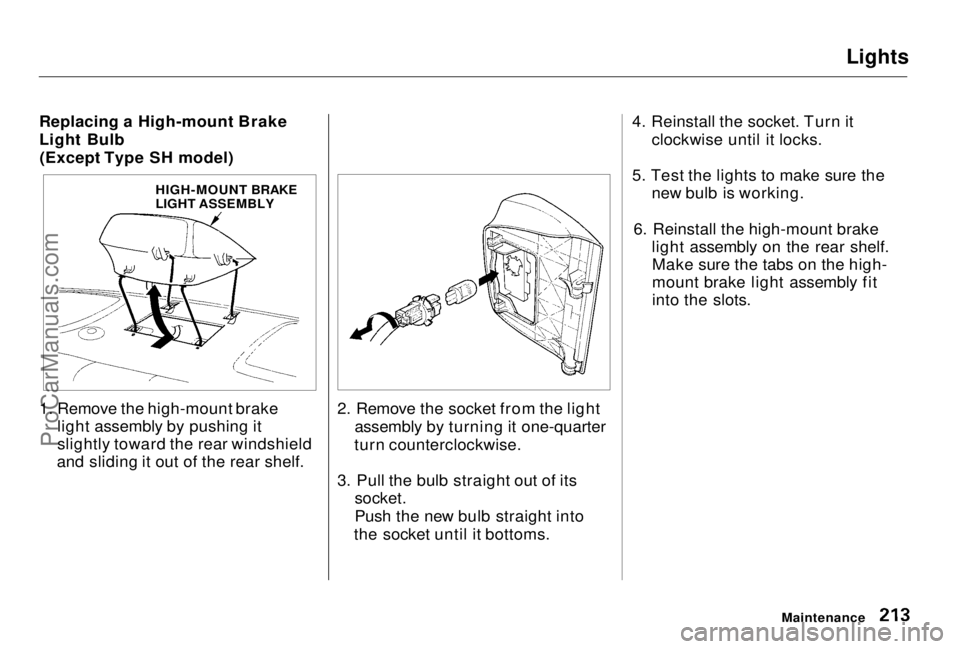
Lights
Replacing a High-mount Brake
Light Bulb (Except Type SH model)
1. Remove the high-mount brake light assembly by pushing it
slightly toward the rear windshield
and sliding it out of the rear shelf. 2. Remove the socket from the light
assembly by turning it one-quarter
turn counterclockwise.
3. Pull the bulb straight out of its socket.
Push the new bulb straight into
the socket until it bottoms. 4. Reinstall the socket. Turn it
clockwise until it locks.
5. Test the lights to make sure the new bulb is working.
6. Reinstall the high-mount brake light assembly on the rear shelf.Make sure the tabs on the high-
mount brake light assembly fit
into the slots.
Maintenance
HIGH-MOUNT BRAKE
LIGHT ASSEMBLYProCarManuals.comMain Menu Table of Contents s t
Page 213 of 278
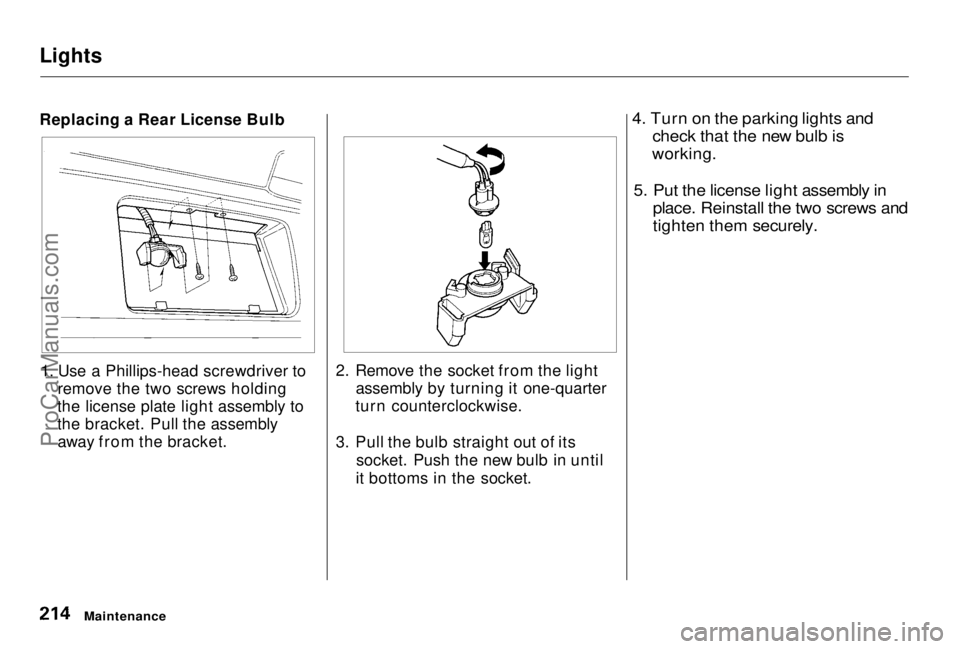
Lights
Replacing a Rear License Bulb
1. Use a Phillips-head screwdriver to remove the two screws holding
the license plate light assembly to
the bracket. Pull the assembly away from the bracket. 2. Remove the socket from the light
assembly by turning it one-quarter
turn counterclockwise.
3. Pull the bulb straight out of its socket. Push the new bulb in until
it bottoms in the socket.
4. Turn on the parking lights and
check that the new bulb is
working.
5. Put the license light assembly in place. Reinstall the two screws and
tighten them securely.
MaintenanceProCarManuals.comMain Menu Table of Contents s t
Page 214 of 278
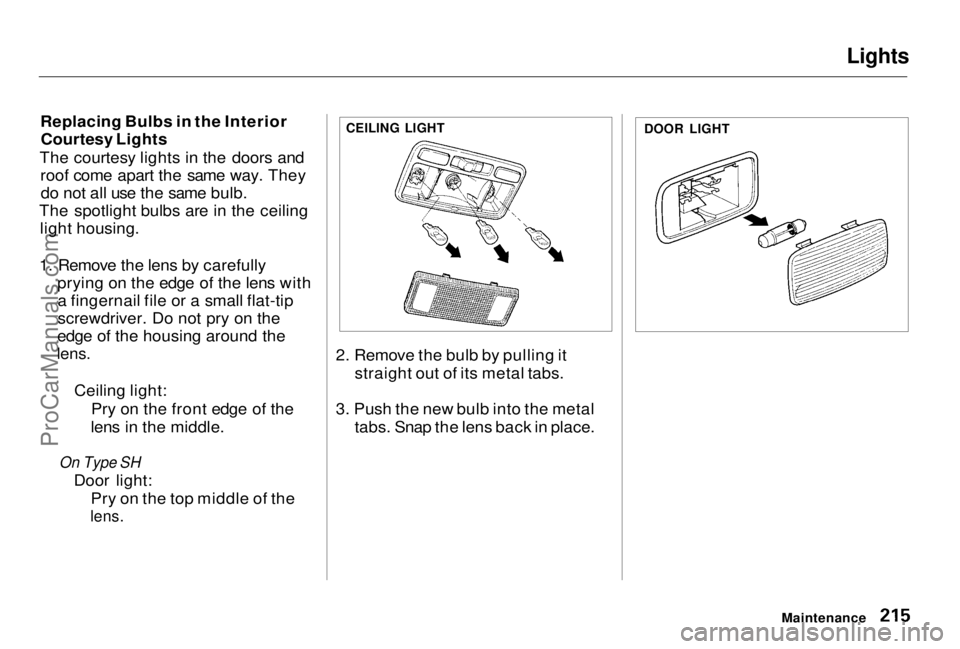
Lights
Replacing Bulbs in the Interior Courtesy Lights
The courtesy lights in the doors and roof come apart the same way. Theydo not all use the same bulb.
The spotlight bulbs are in the ceiling light housing.
1. Remove the lens by carefully prying on the edge of the lens witha fingernail file or a small flat-tip
screwdriver. Do not pry on the
edge of the housing around the
lens.
Ceiling light:Pry on the front edge of the
lens in the middle.
On Type SH
Door light: Pry on the top middle of the
lens.
2. Remove the bulb by pulling it
straight out of its metal tabs.
3. Push the new bulb into the metal tabs. Snap the lens back in place.
Maintenance
DOOR LIGHT
CEILING LIGHTProCarManuals.comMain Menu Table of Contents s t
Page 215 of 278
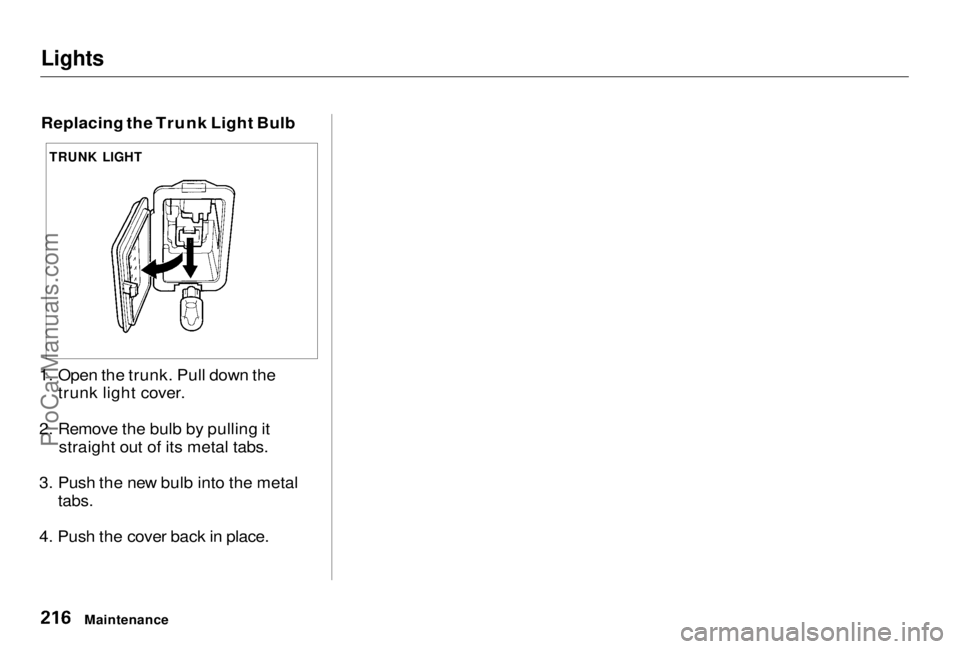
Lights
Replacing the Trunk Light Bulb
1. Open the trunk. Pull down the trunk light cover.
2. Remove the bulb by pulling it straight out of its metal tabs.
3. Push the new bulb into the metal
tabs.
4. Push the cover back in place.
Maintenance
TRUNK LIGHTProCarManuals.comMain Menu Table of Contents s t
Page 216 of 278
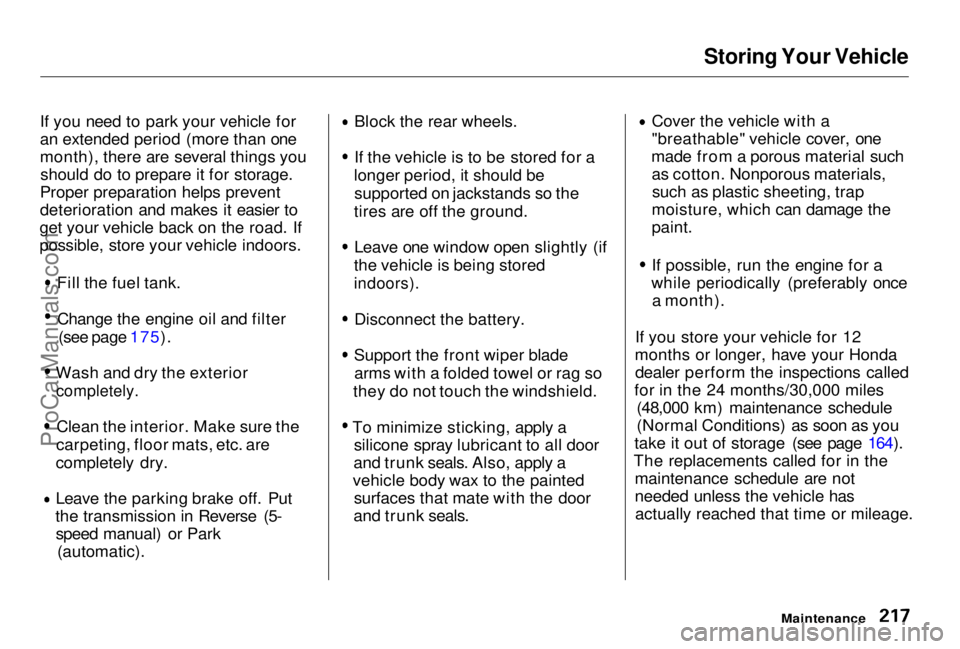
Storing Your Vehicle
If you need to park your vehicle for
an extended period (more than one
month), there are several things you should do to prepare it for storage.
Proper preparation helps prevent
deterioration and makes it easier to
get your vehicle back on the road. If
possible, store your vehicle indoors. Fill the fuel tank.
Change the engine oil and filter
(see page 175). Wash and dry the exterior
completely.
Clean the interior. Make sure the
carpeting, floor mats, etc. are
completely dry.
Leave the parking brake off. Put
the transmission in Reverse (5- speed manual) or Park (automatic). Block the rear wheels. If the vehicle is to be stored for a
longer period, it should be supported on jackstands so the
tires are off the ground. Leave one window open slightly (if
the vehicle is being stored
indoors).
Disconnect the battery.
Support the front wiper blade
arms with a folded towel or rag so
they do not touch the windshield.
To minimize sticking, apply a silicone spray lubricant to all door
and trunk seals. Also, apply a
vehicle body wax to the painted surfaces that mate with the door
and trunk seals. Cover the vehicle with a
"breathable" vehicle cover, one
made from a porous material such as cotton. Nonporous materials,such as plastic sheeting, trap
moisture, which can damage the
paint. If possible, run the engine for a
while periodically (preferably once a month).
If you store your vehicle for 12
months or longer, have your Honda dealer perform the inspections called
for in the 24 months/30,000 miles (48,000 km) maintenance schedule
(Normal Conditions) as soon as you
take it out of storage (see page 164).
The replacements called for in the maintenance schedule are not
needed unless the vehicle hasactually reached that time or mileage.
MaintenanceProCarManuals.comMain Menu Table of Contents s t
Page 217 of 278

Appearance Care
Regular cleaning and polishing of
your Honda helps to keep it "new" looking. This section gives you hintson how to clean your vehicle and
preserve its appearance: the paint,
brightwork, wheels and interior. Also included are several things you can
do to help prevent corrosion.
Exterior Care.................................. 220
Washing......................................220
Waxing........................................221
Aluminum Wheels.....................221
Paint Touch-up........................... 221
Interior Care................................... 222
Carpeting.................................... 222
Fabric.......................................... 222
Vinyl............................................ 222
Seat Belts.................................... 223
Windows..................................... 223
Air Fresheners........................... 224
Corrosion Protection..................... 224
Body Repairs.................................. 225
Appearance CareProCarManuals.comMain Menu s t
Page 218 of 278

Exterior Care
Washing
Frequent washing helps preserve
your vehicle's beauty. Dirt and grit can scratch the paint, while tree sap
and bird droppings can permanently
ruin the finish.
Wash your vehicle in a shady area, not in direct sunlight. If the vehicle is
parked in the sun, move it into the shade and let the exterior cool down
before you start.
Only use the solvents and cleaners
recommended in this Owner's
Manual.
Chemical solvents and strong cleaners
can damage the paint, metal, and
plastic on your vehicle.
Rinse the vehicle thoroughly with
cool water to remove loose dirt. Fill a bucket with cool water. Mix
in a mild detergent, such as
dishwashing liquid or a product
made especially for vehicle
washing.
Wash the vehicle using the water and detergent solution and a soft-
bristle brush, sponge, or soft cloth. Start at the top and work your waydown. Rinse frequently.
Check the body for road tar, tree sap, etc. Remove these stains with
tar remover or turpentine. Rinse it off immediately so it does not
harm the finish. Remember to re-
wax these areas, even if the rest of the vehicle does not need waxing. When you have washed and rinsed
the whole exterior, dry it with achamois or soft towel. Letting it
air-dry will cause dulling and water
spots.
As you dry the vehicle, inspect it for chips and scratches that could allow
corrosion to start. Repair them with
touch-up paint (see page 221).
Appearance Care
NOTICEProCarManuals.comMain Menu Table of Contents s t
Page 219 of 278

Exterior Care
Waxing
Always wash and dry the whole vehicle before waxing it. You should
wax your vehicle, including the metal
trim, whenever water sits on the surface in large patches. It should
form into beads or droplets after
waxing.
You should use a quality liquid or paste wax. Apply it according to theinstructions on the container. In
general, there are two types of
products:
Waxes — A wax coats the finish and protects it from damage by exposure
to sunlight, air pollution, etc. Youshould use a wax on your Honda
when it is new.
Polishes — Polishes and cleaner/
waxes can restore the shine to paint
that has oxidized and lost some of its shine. They normally contain mild
abrasives and solvents that remove the top layer of the finish. You
should use a polish on your Honda if
the finish does not have its original shine after using a wax.
Cleaning tar, insects, etc. with
removers also takes off the wax. Remember to re-wax those areas,
even if the rest of the vehicle does
not need waxing.
Aluminum Wheels Clean your Honda's aluminum alloy
wheels as you do the rest of the exterior. Wash them with the same
solution, and rinse them thoroughly.
The wheels have a protective clear- coat that keeps the aluminum from
corroding and tarnishing. Using
harsh chemicals, including some
commercial wheel cleaners, or stiff
brushes can damage this clear-coat. Only use a mild detergent and soft
brush or sponge to clean the wheels.
Paint Touch-up
Your dealer has touch-up paint to match your vehicle's color. The color
code is printed on a sticker on the
driver's doorjamb. Take this code to
your dealer so you are sure to get the correct color.
Inspect your vehicle frequently for
chips or scratches in the paint.
Repair them right away to prevent corrosion of the metal underneath.
Use the touch-up paint only on small
chips and scratches. More extensive
paint damage should be repaired by
a professional.
Appearance CareProCarManuals.comMain Menu Table of Contents s t
Page 220 of 278

Interior Care
Carpeting
Vacuum the carpeting frequently to remove dirt. Ground-in dirt will make
the carpet wear out faster. Periodically shampoo the carpet to
keep it looking new. Use one of the
foam-type carpet cleaners on the market. Follow the instructions that
come with the cleaner, applying it
with a sponge or soft brush. Keep the carpeting as dry as possible bynot adding water to the foam. Fabric
Vacuum dirt and dust out of the material frequently. For generalcleaning, use a solution of mild soap
and lukewarm water, letting it air dry.
To clean off stubborn spots, use a commercially-available fabric cleaner.
Test it on a hidden area of the fabric first, to make sure it does not bleachor stain the fabric. Follow the
instructions that come with the
cleaner.
Vinyl
Remove dirt and dust with a vacuum
cleaner. Wipe the vinyl with a soft
cloth dampened in a solution of mildsoap and water. Use the same
solution with a soft-bristle brush on
more difficult spots. You can also use
commercially-available spray or
foam-type vinyl cleaners.
Appearance CareProCarManuals.comMain Menu Table of Contents s t